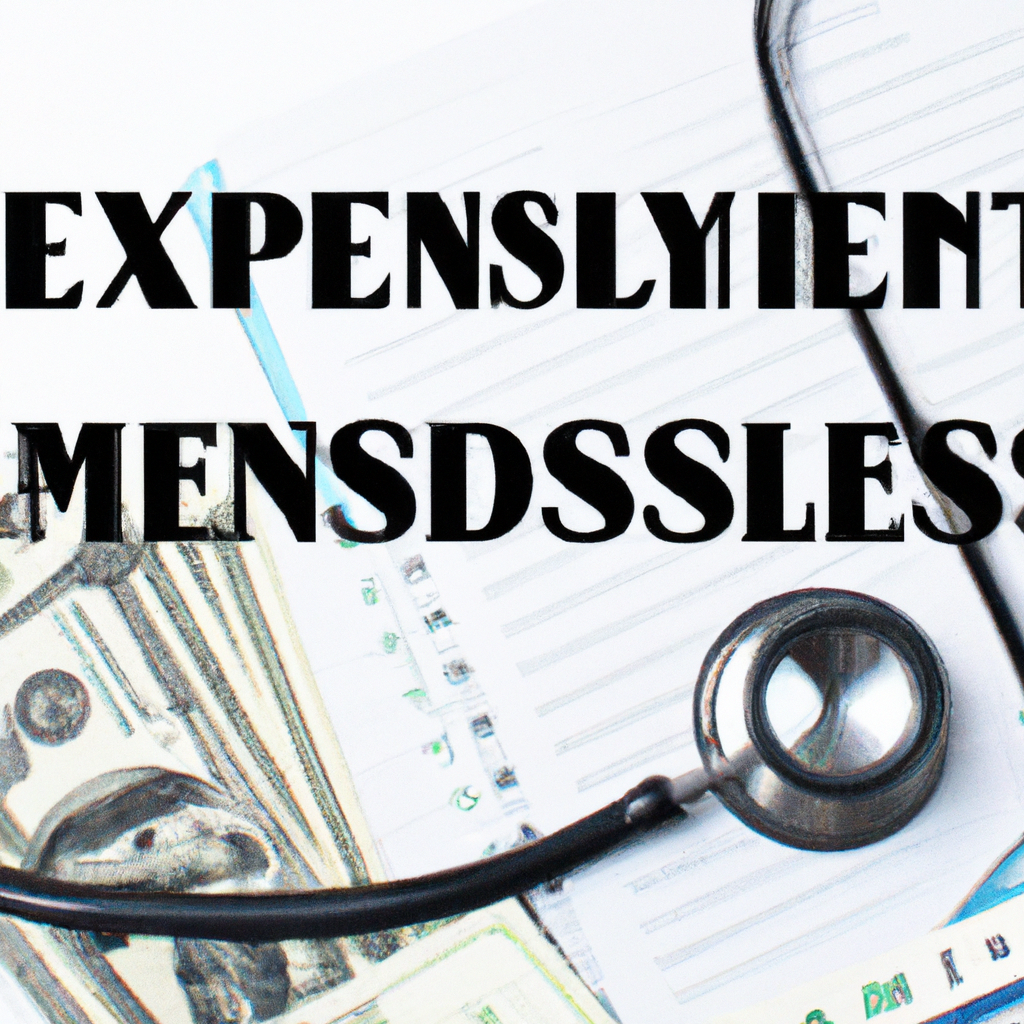If you find yourself burdened by medical expenses, there may be a silver lining in the form of potential deductions. By taking advantage of tax laws, you may be able to deduct medical expenses that exceed a certain percentage of your adjusted gross income (AGI). This means that if your medical expenses reach a certain threshold, you can subtract them from your AGI, potentially reducing your tax burden and providing some much-needed relief. In this article, we will explore the details of this deduction and how it can benefit you. So, let’s dive in and discover how deducting medical expenses can offer financial respite when you need it most in this article ‘Maximize Your Tax Savings: A Guide to Deducting Medical Expenses’.
What are Medical Expenses?
Definition of Medical Expenses
Medical expenses refer to the costs incurred for healthcare services and treatments in order to maintain or improve one’s physical or mental well-being. These expenses can include a wide range of healthcare-related costs, such as doctor visits, hospital stays, prescription medications, medical tests, surgeries, dental treatments, and even certain alternative therapies or medical devices. The Internal Revenue Service (IRS) allows individuals to deduct qualifying medical expenses that exceed a certain percentage of their adjusted gross income (AGI) when filing their income taxes.
Types of Medical Expenses
Medical expenses can be categorized into different types based on their purpose and nature. Some common types of medical expenses include:
- Healthcare Services: This category includes expenses related to doctor visits, hospital stays, ambulance services, nursing care, and home healthcare services.
- Prescription Medications: Expenses for prescription drugs that are prescribed by a healthcare professional and purchased at a pharmacy are considered eligible medical expenses.
- Medical Tests and Procedures: Costs incurred for medical tests, laboratory services, X-rays, MRIs, CT scans, and other diagnostic procedures are also included.
- Surgeries and Medical Procedures: Expenses for surgeries, medical procedures, and treatments, such as childbirth, organ transplants, or joint replacements, are considered qualifying medical expenses.
- Mental Health Services: Costs associated with mental health services, therapy sessions, counseling, and psychiatric treatments are eligible medical expenses.
- Dental and Vision Care: Expenses for preventive and restorative dental treatments, orthodontics, eye exams, prescription eyeglasses, contact lenses, and necessary vision correction surgeries are included.
- Medical Equipment and Supplies: Costs for durable medical equipment, such as wheelchairs, crutches, oxygen supplies, and prosthetic devices, qualify as medical expenses.
It is important to note that not all healthcare-related costs are eligible for deductions. The IRS has specific guidelines and limitations on what can be considered as qualifying medical expenses for tax purposes. It is advisable to consult with a tax professional or refer to IRS publications for detailed information on eligible expenses.
Adjusted Gross Income (AGI)
Understanding AGI
Adjusted Gross Income (AGI) is a term used in the United States to determine an individual’s taxable income. It represents the total amount of income earned from various sources, such as wages, self-employment income, rental income, capital gains, and dividends, with certain adjustments made to arrive at a lower taxable income. AGI is an important factor in determining the threshold for deducting medical expenses.
Calculating AGI
To calculate your AGI, you need to start with your total income, including wages, salaries, tips, and any other sources of income. From this total, you can subtract certain deductions such as contributions to retirement accounts, alimony payments, and student loan interest, among others. The resulting figure is your AGI.
It is crucial to have an accurate calculation of your AGI, as it determines the threshold for deducting medical expenses. The higher your AGI, the higher the percentage of medical expenses that must exceed it in order to be eligible for a deduction. Keep in mind that tax laws and regulations may change, so it is advisable to consult a tax professional or refer to the latest IRS guidelines for specific information regarding AGI calculation.

Percentage of AGI for Deductions
Threshold for Medical Expense Deductions
The IRS sets a threshold for deductible medical expenses, which is based on a percentage of your AGI. For most taxpayers, the threshold is typically 7.5% of their AGI. This means that only medical expenses that exceed 7.5% of their AGI are eligible for deduction.
However, it is essential to note that the threshold for deducting medical expenses can vary based on factors such as age and tax filing status. For individuals who are 65 years of age or older, the threshold remains at 7.5% until 2026. After that, it will increase to 10% of AGI. Married couples who file jointly, where one spouse is 65 or older, also have a 7.5% threshold until 2026. Other taxpayers, including those who are married and filing separately, generally have a higher 10% threshold.
Determining the Threshold
To determine the applicable threshold for your medical expense deductions, you will need to calculate your AGI and multiply it by the respective percentage established by the IRS. For example, if your AGI is $50,000 and you are younger than 65, your threshold would be $5,000 (10% of $50,000). Therefore, only medical expenses that exceed $5,000 would be eligible for deduction.
It is important to keep track of your medical expenses throughout the year and compare them to your AGI to determine if you meet the threshold required for deductions. As the threshold can change with new tax laws or regulations, consulting a tax professional or referring to the latest IRS guidelines is advisable to ensure accurate calculations.
Qualifying Medical Expenses
Eligible Medical Expenses
To claim deductions for medical expenses, the expenses incurred must meet certain criteria set by the IRS. Qualifying medical expenses must satisfy the following conditions:
- Necessary and Preventive: The expenses must be for the prevention, diagnosis, or treatment of a physical or mental illness, including dental and vision care.
- Prescribed by a Professional: The expenses must be prescribed by a licensed healthcare professional, such as a doctor, dentist, psychiatrist, or other qualified medical practitioners.
- Not Reimbursed: The expenses must not have been reimbursed or covered by insurance or any other party, such as an employer or government program.
Eligible medical expenses can cover a wide range of treatments, procedures, medications, and healthcare services. However, some expenses that are typically not considered qualifying medical expenses include cosmetic procedures, non-prescription drugs, general health club memberships, and expenses primarily for personal convenience.
Ineligible Medical Expenses
Certain expenses, even if related to healthcare, may not qualify for medical expense deductions. Some examples of ineligible medical expenses include:
- Cosmetic Procedures: Expenses for purely cosmetic procedures, such as elective surgeries for aesthetic purposes, hair transplants, or teeth whitening, are typically not deductible.
- Over-the-Counter Medications: Non-prescription drugs, vitamins, supplements, and other similar items that can be purchased without a prescription are generally not deductible.
- General Health Expenses: Expenses related to general health maintenance, such as gym or fitness club memberships, weight loss programs (unless prescribed by a healthcare professional), and non-prescribed dietary supplements, are not considered qualifying medical expenses.
It is crucial to review the IRS guidelines and consult a tax professional to determine if specific expenses qualify as deductible medical expenses.

Documentation for Medical Expense Deductions
Required Documents
When claiming medical expense deductions on your tax return, it is essential to maintain accurate and organized documentation to support your claims. The IRS may require you to provide documentation when audited or to validate your deductions. Some essential documents to keep include:
- Bills and Receipts: Keep all itemized bills and receipts for medical treatments, services, prescriptions, and other qualifying expenses. Ensure they include the date, the name and address of the service provider, a description of the service, and the amount paid.
- Insurance Statements: Retain copies of insurance statements, explanations of benefits, and any other correspondence from your insurance company related to the medical expenses incurred.
- Prescriptions and Pharmacy Records: Maintain records of prescriptions, receipts from the pharmacy, and any necessary documentation related to medication expenses.
- Mileage Log: If you traveled for medical purposes, keep a mileage log detailing the dates, locations, and mileage incurred. This applies to both personal vehicles and public transportation costs.
Tracking and Organizing Expenses
To simplify the process of tracking and organizing your medical expenses, consider creating a specific folder or file for all relevant documentation. As you incur medical expenses throughout the year, ensure that all related receipts, bills, statements, and other relevant documents are promptly filed. Digital copies or scanned versions of physical documents can also be stored securely to maintain a backup.
Maintaining a spreadsheet or utilizing dedicated personal finance software can also help track and categorize expenses. This can assist in calculating your AGI, determining whether you meet the threshold for medical expense deductions, and providing accurate information when filing your taxes.
By maintaining meticulous records and organizing your documentation, you can ensure that you have the necessary support in case of an audit or when claiming medical expense deductions.
Claiming Medical Expense Deductions
Filing Status and Deduction Limitations
When filing your taxes, the method and eligibility for claiming medical expense deductions can depend on your filing status. The most common filing statuses are:
- Single: This status applies to individuals who are not married or are legally separated according to state law.
- Married Filing Jointly: This status applies to married couples who choose to file a joint tax return.
- Married Filing Separately: This status applies to married couples who choose to file separate tax returns.
- Head of Household: This status applies to individuals who are unmarried but pay more than half the cost of maintaining a home for themselves and a qualifying dependent.
Each filing status has its own deduction limitations and requirements, so it is crucial to understand the specific rules that apply to your situation. The IRS provides detailed information on deduction limitations and eligibility criteria in its publications and guidelines.
Using Schedule A
To claim medical expense deductions, you will generally need to itemize your deductions on your tax return using Schedule A, which is a form provided by the IRS. Schedule A allows you to report your eligible medical expenses, along with other itemized deductions such as state and local taxes, mortgage interest, and charitable contributions.
When completing Schedule A, carefully follow the instructions and guidelines provided by the IRS. Ensure that you accurately report your qualifying medical expenses and calculate the correct deduction amount based on your AGI and the applicable threshold.
Special Rules for Dependents
If you have a dependent, such as a child or elderly parent, who incurs medical expenses, there are additional considerations and possibilities for claiming deductions. Depending on your situation, you may be able to include your dependents’ medical expenses as part of your own deductions.
To claim medical expenses for a dependent, you must meet certain criteria. For example, you generally need to provide more than half of the individual’s financial support, and their medical expenses must qualify as deductible medical expenses according to IRS guidelines. Consult a tax professional or refer to the IRS guidelines for specific rules and requirements when claiming medical expense deductions for dependents.

Planning Strategies for Maximizing Deductions
Bunching Medical Expenses
One strategy to maximize your medical expense deductions is to strategically bunch your expenses within a single tax year. By accelerating or delaying certain medical treatments or procedures, you can potentially reach the threshold required for deductions.
For example, if you anticipate a significant medical procedure that would exceed the threshold in the next year, consider scheduling it in the current year to combine it with any other qualifying expenses. This can help ensure that the total medical expenses exceed the threshold, making them eligible for deduction.
Similarly, if you have already met the threshold for the current year, consider scheduling any non-urgent medical treatments or procedures for the following year. By delaying these expenses, you can potentially maximize your deductions in both years.
However, it is vital to carefully consider the financial and healthcare implications of bunching medical expenses. Consult with healthcare professionals and a tax advisor to assess whether this strategy is appropriate for your circumstances.
Including Dependents’ Medical Expenses
If you are eligible to claim medical expense deductions for your dependents, including their medical expenses can help increase your total eligible deductions. Ensure that you have accurate records of their qualifying expenses and follow the IRS guidelines for claiming deductions related to dependents.
By effectively tracking and including their medical expenses along with your own, you can potentially reach the threshold for deductions more easily and maximize your overall tax benefits.
Potential Pitfalls to Avoid
Exceeding the Deduction Threshold
One common pitfall when deducting medical expenses is failing to meet the threshold required for deductions. It is important to carefully calculate your AGI and determine the applicable percentage threshold for your situation. Track your medical expenses throughout the year and compare them to your AGI to ensure that you meet the required threshold.
If you are close to the threshold, consider utilizing planning strategies such as bunching expenses or including dependents’ medical expenses to maximize your deductions. However, it is crucial to avoid artificially inflating expenses or claiming ineligible expenses, as this can lead to potential legal and financial consequences.
Not Keeping Proper Documentation
Failure to maintain accurate and organized documentation for your medical expenses can create difficulties when claiming deductions or in the event of an audit. Ensure that you keep all relevant receipts, bills, statements, and other supporting documents in a secure and accessible manner.
Regularly update your documentation throughout the year and verify the accuracy of all information provided. By doing so, you can minimize the risk of errors, disputes, or challenges with the IRS regarding your medical expense deductions.
Mistakes in Calculating AGI
Calculating your AGI accurately is crucial when determining the threshold for medical expense deductions. Errors in calculating your AGI can lead to misjudging your eligibility for deductions and potentially result in incorrect tax filings.
To avoid mistakes in calculating your AGI, enlist the assistance of a tax professional or utilize reliable tax software that can guide you through the process. Double-check all entries and calculations to ensure accuracy and consult the latest IRS guidelines or publications for specific AGI calculation rules.

Other Tax Deductions and Credits Related to Medical Expenses
Health Savings Accounts (HSA)
Health Savings Accounts (HSAs) can provide additional tax benefits for individuals who have high-deductible health insurance plans. Contributions made to an HSA are tax-deductible, and the funds within the account can be used to pay for qualified medical expenses without being subject to tax.
Contributions to an HSA can be made by both you and your employer, up to certain limits set by the IRS. The funds contributed to an HSA can be invested and grow tax-free, providing additional financial benefits.
Consult a tax professional or refer to the latest IRS guidelines for specific rules and regulations regarding HSAs and their potential tax advantages.
Itemized Deductions vs. Standard Deduction
When filing your taxes, you have the option to claim either itemized deductions or take the standard deduction. For some taxpayers, itemizing deductions, including medical expenses, can provide greater tax benefits than the standard deduction.
To assess which option is more advantageous for you, compare the total amount of your itemized deductions, including medical expenses, to the applicable standard deduction for your filing status. If your itemized deductions exceed the standard deduction, itemizing can help maximize your tax savings.
However, it is essential to evaluate your personal situation and consult a tax professional to determine the best approach for your specific circumstances.
Other Medical Tax Benefits
In addition to deducting medical expenses, there may be other tax benefits related to healthcare and medical expenses that you can consider. For example, tax credits, such as the Premium Tax Credit or the Child and Dependent Care Credit, can provide additional tax relief for qualifying healthcare-related expenses.
Explore the various tax credits and benefits available to determine if you qualify and to maximize your overall tax savings. Review the IRS guidelines or consult with a tax professional for detailed information on specific tax credits and benefits.
Consulting a Tax Professional
Seeking Expert Advice
Navigating the complex world of tax deductions, especially when it comes to medical expenses, can be challenging. To ensure that you maximize your eligible deductions and comply with all IRS rules and regulations, it is highly recommended to seek expert advice from a qualified tax professional.
Tax professionals, such as certified public accountants (CPAs) or enrolled agents, have in-depth knowledge of tax laws, current regulations, and available deductions. They can provide tailored advice based on your specific circumstances and guide you through the process of claiming medical expense deductions accurately.
By consulting a tax professional, you can gain peace of mind, optimize your tax savings, and minimize the risk of errors or disputes with the IRS.
Considering Tax Law Changes
Tax laws and regulations are subject to change, and it is crucial to stay informed about any updates that may affect your medical expense deductions. From changes in the threshold for deductibility to new tax credits or benefits related to healthcare, remaining up to date is essential for accurate tax filings.
Regularly review the latest IRS publications, guidelines, and relevant tax law updates to ensure that you are aware of any changes that may impact your tax planning strategies and deductions. Consulting a tax professional can also help you navigate and interpret these changes effectively.
In conclusion, deducting medical expenses that exceed a certain percentage of your adjusted gross income (AGI) can provide significant tax benefits. Understanding the definition of medical expenses, the calculation of AGI, the threshold for deductions, and eligible expenses is crucial when claiming these deductions. Maintaining accurate documentation, consulting a tax professional, and staying informed about tax law changes can help you optimize your deductions and maximize your tax savings. By carefully following the IRS guidelines and utilizing appropriate tax planning strategies, you can ensure compliance and potentially reduce your tax liability.


